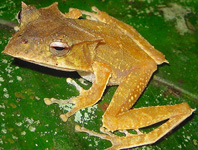Abstract
We reviewed the taxonomic status of populations of frogs in the genus Hemiphractus in Panama, which have all been referred to Hemiphractus fasciatus Peters, 1862 for over 40 years. Although relatively few specimens have been collected, mostly juveniles, it is clear that these frogs inhabit three separate upland regions of the country: The Cordillera de Talamanca in western Panama, the Chagres Highlands and Cordillera de San Blas in central Panama, and the Serranía de Pirre in the far eastern portion of the country. In accordance with previously published molecular data, we identified distinctive features of the skulls of frogs representing these three allopatric populations and herein revalidate H. panamensis (Stejneger, 1917), describe the new species Hemiphractus elioti sp. nov. from the Cordillera de Talamanca, and the new species Hemiphractus kaylockae sp. nov. from the Serranía de Pirre. We also propose that the taxon H. fasciatus is a South American species not occurring in Panama.
References
Castroviejo-Fisher, S., Padial, J., de La Riva, I., Pombal Junior, J., da Silva, H., Rojas-Runjaic, F.J.M., Medina-Méndez, E. & Frost, D. (2015) Phylogenetic systematics of egg-brooding frogs (Anura: Hemiphractidae) and the evolution of direct development. Zootaxa, 4004 (1), 1–75.
https://doi.org/10.11646/zootaxa.4004.1.1Coloma, L., Ron, S., Jungfer, K., Solís, F., Ibáñez, R., Jaramillo, C., Fuenmayor, Q. & Bolaños, F. (2008) Hemiphractus fasciatus. The IUCN Red List of Threatened Species.
https://doi.org/10.2305/IUCN.UK.2008.RLTS.T55367A11286659.enCrawford, A., Cruz, C., Griffith, E., Ross, H., Ibáñez, R., Lips, K. & Crump, P. (2012) DNA barcoding applied to ex situ tropical amphibian conservation programme reveals cryptic diversity in captive populations. Molecular Ecology Resources, 13, 1005–1018.
Duellman, W. (1970) The hylid frogs of Middle America. Vol. 1. Monograph of the Museum of Natural History, University of Kansas, 1, 1–427.
Duellman, W. (2001) The Hylid Frogs of Middle America. Vol. 2. Society for the Study of Amphibians and Reptiles Contributions in Herpetology, Ithaca, New York, 1170 pp.
Duellman, W., Maxson, L. & Jesiolowski, C. (1988) Evolution of marsupial frogs (Hylidae: Hemiphractinae): immunological evidence. Copeia, 1988, 527–543.
https://doi.org/10.2307/1445371Hill, R., Kaylock, J., Cuthbert, E. Griffith, E. & Ross, H. (2012) Observations on the captive maintenance and reproduction of the Cascade Glass Frog, Sachatamia albomaculata. Herpetological Review, 43, 601–604.
Jiménez de la Espada, M. (1871) Faunae neotropicalis species quaedam nondum cognitae. Journal of Science, Math, and Physics of the National Academy of Real Sciences, 3, 57–65.
Kӧhler, G. (2011) Amphibians of Central America. Herpeton Elke Kӧhler, Offenbach, 379 pp.
Lips, K., Brem, F., Brenes, R., Reeve, J., Alford, R., Voyles, J., Carey, C., Livo, L., Pessier, A. & Collins, J. (2006) Emerging infectious disease and the loss of biodiversity in a Neotropical amphibian community. Proceedings of the National Academy of Sciences, USA, 103, 3165–3170.
https://doi.org/10.1073/pnas.0506889103Myers, C. (1966) The distribution and behavior of a tropical horned frog Cerathyla panamensis Stejneger. Herpetologica, 22, 68–71.
Myers, C., Ibáñez, R., Grant, T. & Jaramillo, C. (2012) Discovery of the frog genus Anomaloglossus in Panama, with descriptions of two new species from the Chagres Highlands (Dendrobatidae: Aromobatidae). American Museum Novitates, 3763, 1–19.
https://doi.org/10.1206/3763.2Noble, G. (1926) An analysis of the remarkable cases of distribution among the Amphibia, with description of new genera. American Museum Novitates, 212, 1–24.
Peters, W. (1862) Uber de Batrachier-Gattung Hemphractus. Montsberichte de Königlichen Preussische Akademie de Wissenschaften zu Berlin, 1862, 144–152.
Sabaj-Perez, M. (2016) Standard symbolic codes for institutional resource collections in herpetology and ichthyology: an online reference. Version 6.5 (16 August 2016). American Society of Ichthyologists and Herpetologists, Washington, D.C. Electronically accessible from: http://www.asih.org/ (accessed 15 February 2017)
Sheil, C. & Mendelson III, J. (2001) A new species of Hemiphractus (Anura: Hylidae: Hemiphractinae), and a redescription of H. johnsoni. Herpetologica, 57, 189–202.
Sheil, C., Mendelson III, J. & da Silva, H. (2001) Phylogenetic relationships of the species of Neotropical horned frogs, genus Hemiphractus (Anura: Hylidae: Hemiphractinae), based on evidence from morphology. Herpetologica, 2, 203–214.
Stejneger, L. (1917) A new species of horned tree-toad from Panama. Proceedings of the Biological Society of Washington, 301, 31–34.
Trueb, L. (1974) Systematic relationships of Neotropical horned frogs, genus Hemiphractus (Anura: Hylidae). Occasional Papers of the Museum of Natural History, University of Kansas, 29, 1–60.
https://doi.org/10.5962/bhl.part.11750Wagler, J. (1828) Auzuge aus einem systema amphibiorem. Isis von Oken, 1828, 740–744.
Wiens, J., Kuczynski, C., Duellman, W. & Reeder, T. (2007) Loss and re-evolution of complex life-cycles in marsupial frogs: does ancestral trait reconstruction mislead? Evolution, 61, 1886–1899.
https://doi.org/10.1111/j.1558-5646.2007.00159.x

